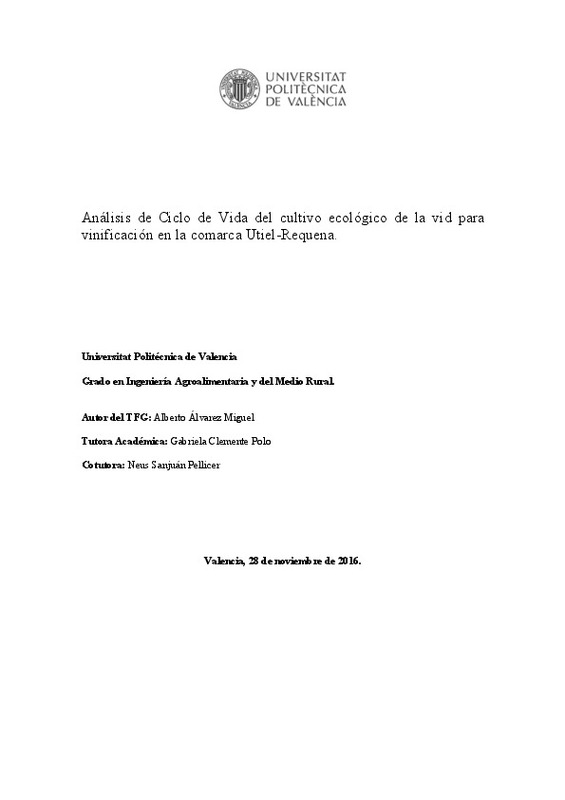|
[ES] Debido a la actual y creciente preocupación por el medioambiente y a la implicación del hombre
en impactos medioambientales surge la necesidad de conocer en qué medida el ser humano
contribuye a los impactos ...[+]
[ES] Debido a la actual y creciente preocupación por el medioambiente y a la implicación del hombre
en impactos medioambientales surge la necesidad de conocer en qué medida el ser humano
contribuye a los impactos ambientales. La agricultura es una de las actividades humanas que
genera impactos sobre el medioambiente. Por lo tanto, conocer hasta qué punto afectan las
prácticas agrícolas permitirá establecer hábitos que contribuyan a la disminución de los impactos
ambientales. El cultivo de la vid en la comarca Utiel-Requena es uno de los más extensos y que
representa una mayor importancia económica en la Comunidad Valenciana.
Este trabajo contribuye a la temática “Tecnología de la Producción Hortofrutícola. Principios de
desarrollo sostenible”. En el presente estudio se pretenden calcular los impactos ambientales del
cultivo ecológico de la vid para vinificación en la comarca Utiel-Requena. Para ello se
considerarán todas las etapas que se llevan a cabo en el proceso de producción de la vid, con el
fin de evaluarlas y poder estudiar sus impactos en el medioambiente. Con el objetivo de valorar
los impactos ambientales que se generan en una campaña de producción del cultivo de la vid se
ha aplicado la metodología de análisis de ciclo de vida (ACV) de acuerdo con las normas ISO
14040:2006 e ISO 14044:2006. Con este fin, se han recopilado los datos de inventario y se ha
realizado la evaluación mediante el programa informático GaBi 6.0.
Al analizar las emisiones en cada explotación se puede concluir que no hay diferencias muy
grandes entre explotaciones. Esto es debido a que las prácticas culturales llevadas a cabo son
similares. Por otra parte, se estima que la etapa de producción de fitosanitarios es la que
contribuye a un mayor número de categorías de impacto seguida de la etapa de producción de
energía eléctrica para riego y de la de cultivo.
[-]
[EN] On account of the current and important worry by the environment and the implication of the man
in the environmental impacts arises the need to know in what measured the human being is
responsible of his acts and ...[+]
[EN] On account of the current and important worry by the environment and the implication of the man
in the environmental impacts arises the need to know in what measured the human being is
responsible of his acts and like this reduce these effects. The agriculture is one of the human
activities that generates impacts of the environment. Therefore, know until which point affect the
practises carried out to produce a crop will allow to establish habits that contribute to his decrease.
The crop of the vineyard in the region Utiel-Requena is one of the most extensive of the Valencian
Community.
This work contributes to the thematic “Technology of the Production Hortofruticola.Principles of
sustainable development”. In the present study pretend calculate the environmental impacts of the
ecological crop of the vineyard for vinification in the region Utiel –Requena. For this will consider
all the stages that carry out in the process of production of the vineyard, with the end to evaluate
them and can study the negative contribution that exert in the environment. With the aim to value
the environmental impacts that generate in a campaign of production of the crop of the vineyard
has applied the methodology of analysis of cycle of life (ACV) in accordance with the norms ISO
14040:2006 and ISO 14044:2006. To this end, they have recuperated the dates of inventory and
has made the evaluation by means of the computer program GaBi 6.0
When analysing the broadcasts in each exploitation can conclude that there are not significant
differences between exploitations. This is due to the fact that the cultural practices carried out are
deuce. On the other hand, it estimates that the stage of application of phytosanitary is the one who
contributes to generate a greater number of categories of impact followed of the stage of irrigation
and of the one of crop.
[-]
|







